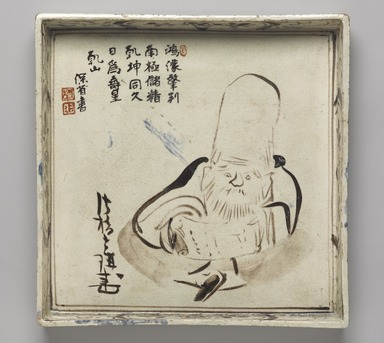
Artist:Ogata KenzanOgata Korin
Medium: Earthenware with underglaze iron-oxide painted decoration
Geograhical Locations:
Dates:1710–1730
Dimensions: 1 1/4 x 8 3/4 x 8 3/4 in. (3.1 x 22.3 x 22.3 cm)
Collections:
Exhibitions:
Accession Number: 40.505
Image: 40.505_PS9.jpg,
Catalogue Description: Edo Period. Potted by Ogata Kenzan (1663-1743), Painted by Ogata Korin (1658-1716). Square dish with raised straight sides; buff pottery covered with cream colored glaze which is irregularly crazed. On the interior, under the glaze, is painted a figure of Jurojin, one of the seven gods of good fortune and representing longevity. The figure, painted in the style of Ogata Korin and accompanied by a signature of the artist (now generally questioned), is represented in a seated position holding a scroll. The drawing is in free style and is in shades of brown. In this same color a floral scroll decorates the sides on the interior and a simpler scroll pattern appears on the sides of the exterior. The dish is in the style of those potted by Ogata Kenzan (b. 1663 - d.1743) and his signature appears on the bottom of the dish. Some blue lines appear in the glaze on the interior as well as in several places on the edge. On the interior above the figure to the left is an inscription painted in black with red seals. Korin's signature appears to the left of the figure, and Kenzan's signature is beside his calligraphy in the upper left hand corner. Condition: good.